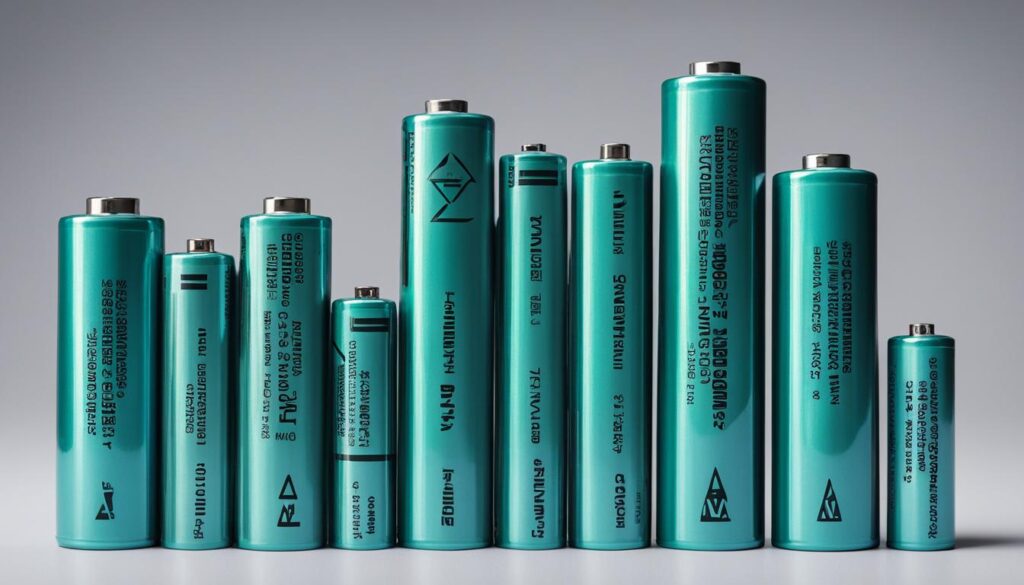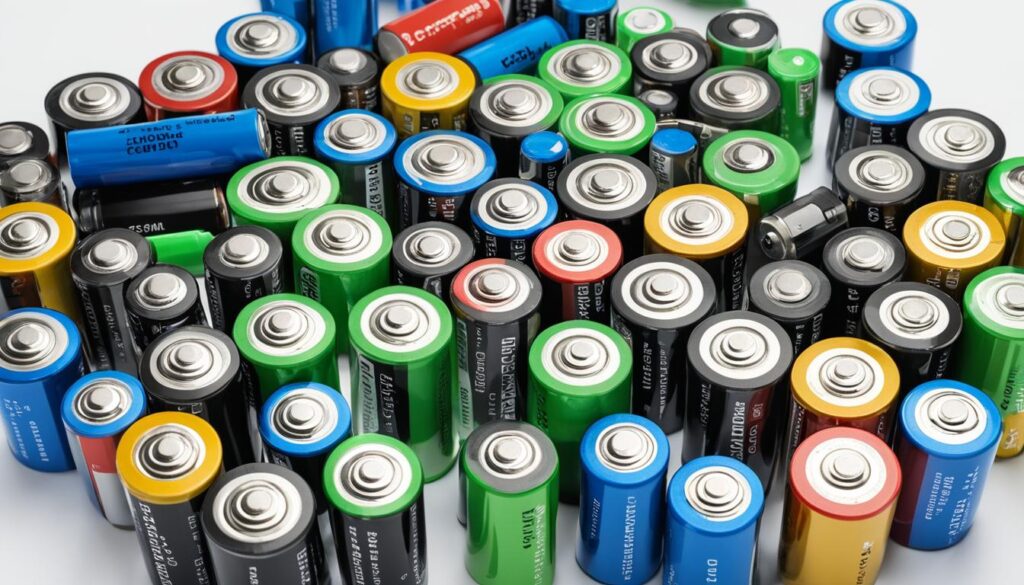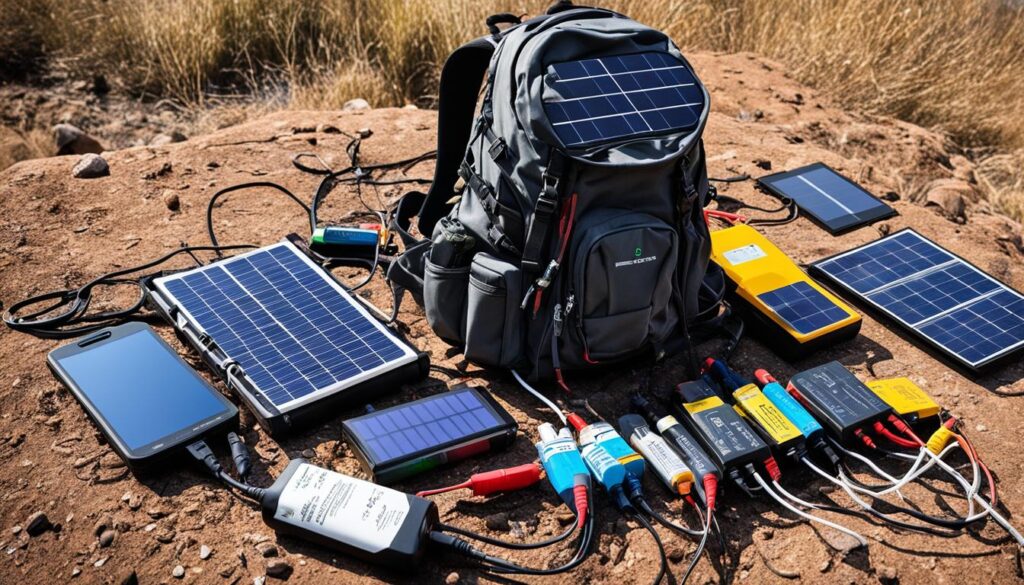
In today’s world, reliable power is essential, especially for preppers who anticipate emergencies and off-grid scenarios. Understanding battery capacities and voltages is crucial for making informed choices when it comes to battery technology. By expanding our knowledge beyond traditional alkaline batteries, we can explore better options that offer longevity, versatility, and reliable power.
Rechargeable batteries, such as NiMH LSD batteries, are a game-changer for preppers. They provide a longer lifespan and can be reused numerous times, making them a cost-effective and eco-friendly choice. On the other hand, lithium-based disposable batteries are ideal for long-term backups, ensuring a reliable power source when other options may not be available.
To navigate the world of batteries effectively, it is important to understand key concepts such as battery capacities, discharge rates, voltage, and the different types of batteries available. Armed with this knowledge, preppers can make informed decisions about which batteries to include in their emergency stockpile and which ones to rely on when the need arises.
Key Takeaways:
- Understanding battery capacities and voltages is crucial for preppers.
- Rechargeable batteries, such as NiMH LSD batteries, offer longevity and versatility.
- Lithium-based disposable batteries are ideal for long-term backups.
- Key concepts to understand include battery capacities, discharge rates, voltage, and the different types of batteries available.
- Making informed decisions about batteries can ensure reliable power in emergencies.
Common Battery Types and Basic 101
Batteries are available in various chemistries and sizes, each with its own characteristics and applications. Understanding the common battery types and their key features is essential when choosing the right batteries for your prepping needs.
Alkaline Batteries
Alkaline batteries are the most commonly used disposable batteries. They are affordable and readily available in a wide range of sizes, making them suitable for a variety of devices. However, alkaline batteries are not recommended for long-term storage due to their tendency to leak and their limited shelf life.
Lithium Batteries
Lithium batteries offer several advantages over alkaline batteries. They have a longer shelf life, enabling them to be stored for extended periods without losing capacity. Lithium batteries also provide higher energy density, meaning they can hold more power in a smaller and lighter package. These batteries are particularly well-suited for high-drain devices and long-term backup power.
NiMH Batteries
NiMH (Nickel Metal Hydride) batteries are rechargeable batteries that offer a good balance between capacity and lifespan. They provide a higher capacity than traditional alkaline batteries and can be recharged numerous times before losing capacity. NiMH batteries are commonly used in portable electronics, such as cameras, and are preferred by environmentally-conscious consumers due to their reusability.
When comparing different battery types, it is important to consider their capacity and charge cycles. Battery capacity is measured in milliamp hours (mAh) and determines the amount of energy a battery can hold. The higher the capacity, the longer the battery will last before needing to be recharged or replaced. Charge cycles indicate the number of times a rechargeable battery can be charged before it starts to lose capacity.

Choosing the Right Batteries for Prepping
When it comes to prepping, the right choice of batteries can make all the difference. In this section, I will discuss the various options available and help you understand which batteries best suit your needs.
Rechargeable Batteries
Rechargeable batteries, such as NiMH LSD batteries, are highly recommended for long-term storage in a prepping scenario. These batteries have a low self-discharge rate, meaning they retain their charge for an extended period. Additionally, they offer a high number of charge cycles, allowing you to reuse them multiple times. This makes them a cost-effective and eco-friendly choice.
Disposable Batteries
Disposable batteries, also known as primary batteries, can still be used in a prepping situation. However, they should not be relied upon as the main source of power, especially in emergency situations. Disposable batteries have a limited lifespan and can quickly lose their charge over time, making them less reliable for long-term needs.
Lithium-Ion Batteries
Lithium-ion batteries are a popular choice for rechargeable batteries due to their high energy density. They offer a significant amount of power in a compact size, making them ideal for portable devices. However, it’s worth noting that lithium-ion batteries have a shorter lifespan compared to NiMH batteries and may require more frequent replacement.
The Pros and Cons of Each Battery Type
Here is a comparison table outlining the pros and cons of each type of battery:
| Battery Type | Pros | Cons |
|---|---|---|
| Rechargeable Batteries | – Low self-discharge rate – Cost-effective in the long run – Environmentally friendly – Multiple charge cycles |
– Initial higher cost – Require a charger |
| Disposable Batteries | – Widely available – Easy to use |
– Limited lifespan – High self-discharge rate – Environmental impact |
| Lithium-Ion Batteries | – High energy density – Compact size – Suitable for portable devices |
– Shorter lifespan – Require more frequent replacement |
When choosing batteries for prepping, consider factors such as capacity, self-discharge rate, and specific requirements. It’s essential to balance your power needs with the practicality and longevity of the batteries you choose. Remember, the right batteries can provide peace of mind and reliable power during challenging times.

Powering Gear in Off-Grid Scenarios
When it comes to off-grid scenarios, preppers require reliable power solutions for their gear. Whether it’s battery-powered devices, portable power options, or fixed solar installations, having a robust power setup is crucial. Let’s explore some of the key options and considerations for powering gear off the grid.
Portable Power Solutions
Portable power solutions offer flexibility and convenience in off-grid situations. High-capacity batteries, such as lithium-ion or deep-cycle batteries, can provide sufficient power for small devices like phones, flashlights, and radios. These lightweight batteries can be easily transported and recharged using portable solar panels, making them ideal for outdoor adventures or emergency situations.

Gas-Powered Generators
Gas-powered generators are another option for off-grid power. They provide a reliable source of electricity, especially for larger devices or appliances. However, they have limitations in terms of portability and fuel availability. Gasoline or propane is required to operate these generators, which means you need to stock up on fuel beforehand. Additionally, gas-powered generators can be noisy and emit fumes, making them less suitable for certain situations.
Fixed Solar Installations
For a constant power supply in off-grid scenarios, fixed solar installations are a popular choice. These setups involve solar panels mounted on rooftops or in open areas to harness solar power. A solar charge controller regulates the power flow to the batteries, ensuring efficient charging. A power inverter is used to convert the DC power from the batteries to AC power, enabling the use of standard household devices. Fixed solar installations require careful planning and may involve additional components like deep-cycle batteries for energy storage.
Understanding AC and DC Power
When setting up power systems for off-grid scenarios, it’s essential to understand the difference between AC (alternating current) and DC (direct current) power. AC power is what we typically use in our homes and requires inverters to convert DC power from batteries or solar panels. DC power, on the other hand, is commonly used by small portable devices and can be provided directly by batteries or solar panels.
Volts and Amps: Key Concepts
Volts and amps are important electrical measurements to consider when designing off-grid power systems. Volts measure the electrical voltage or potential difference, while amps measure the current or flow of electricity. Together, they determine the power capacity and efficiency of a system. Understanding the power requirements of your gear and matching it with the appropriate voltage and current is crucial for optimal functioning.
Comparison of Off-Grid Power Solutions
| Power Solution | Portability | Availability | Power Capacity | Energy Source |
|---|---|---|---|---|
| Portable Power Solutions | High | Good (with solar recharging) | Limited (suitable for small devices) | Battery and Solar Panels |
| Gas-Powered Generators | Low | Good (fuel dependency) | High (suitable for large devices) | Gasoline or Propane |
| Fixed Solar Installations | None (permanent installation) | Good (daylight dependency) | High (scalable depending on system size) | Sunlight |
Example Setups for Powering Devices
When it comes to powering your devices in off-grid scenarios, preppers have various options to consider. The choice of power system depends on specific needs, level of portability, and the devices that need to be powered.
For those requiring flexibility and ease of use, portable power setups are the way to go. These setups typically involve battery banks and portable solar panels. They are perfect for charging small devices like phones and headlamps, providing convenient and reliable power on the go.
If you need a bit more power and are willing to put in some effort, semi-portable power setups are a great choice. These setups consist of larger batteries and solar panels that can be easily moved by hand over short distances. They offer more capacity and versatility, making them suitable for powering a wider range of devices.
On the other hand, for long-term power needs in buildings or vehicles, fixed power installations are the most reliable option. These setups utilize solar panels and generators to provide consistent power. To ensure seamless power supply, inverters, charge controllers, and battery banks are often integrated into the system.
FAQ
What is the importance of understanding battery capacities and voltage for preppers?
Understanding battery capacities and voltage is essential for preppers as it helps them make informed choices when selecting batteries for their power needs. Battery capacities determine how much energy a battery can hold, while voltage affects the power output of the battery.
What are the common types of batteries and their characteristics?
The common types of batteries include alkaline, lithium, and NiMH batteries. Alkaline batteries are widely used but not recommended for long-term storage. Lithium batteries offer longer shelf life and higher capacity, while NiMH batteries provide good capacity and lifespan.
What factors should preppers consider when choosing batteries for their emergency power needs?
Preppers should consider the pros and cons of rechargeable and disposable batteries, the specific needs of their devices, battery capacity, and self-discharge rate. Rechargeable batteries, such as NiMH LSD batteries, are recommended for long-term storage due to their low self-discharge rate and high number of charge cycles.
What are the power solutions available for off-grid scenarios?
Preppers can consider portable power solutions such as high-capacity batteries and portable solar panels for small devices like phones and flashlights. Gas-powered generators offer another option but have limitations on portability and fuel availability. Fixed solar installations provide constant power and often require inverters, charge controllers, and batteries.
What are the different types of power setups that preppers can create for their devices?
Preppers can set up portable power setups using battery banks and portable solar panels for small devices that require mobility. Semi-portable setups involve larger batteries and solar panels that can be moved by hand over short distances. Fixed power installations, including solar panels and generators, are suitable for long-term power needs in buildings or vehicles.


